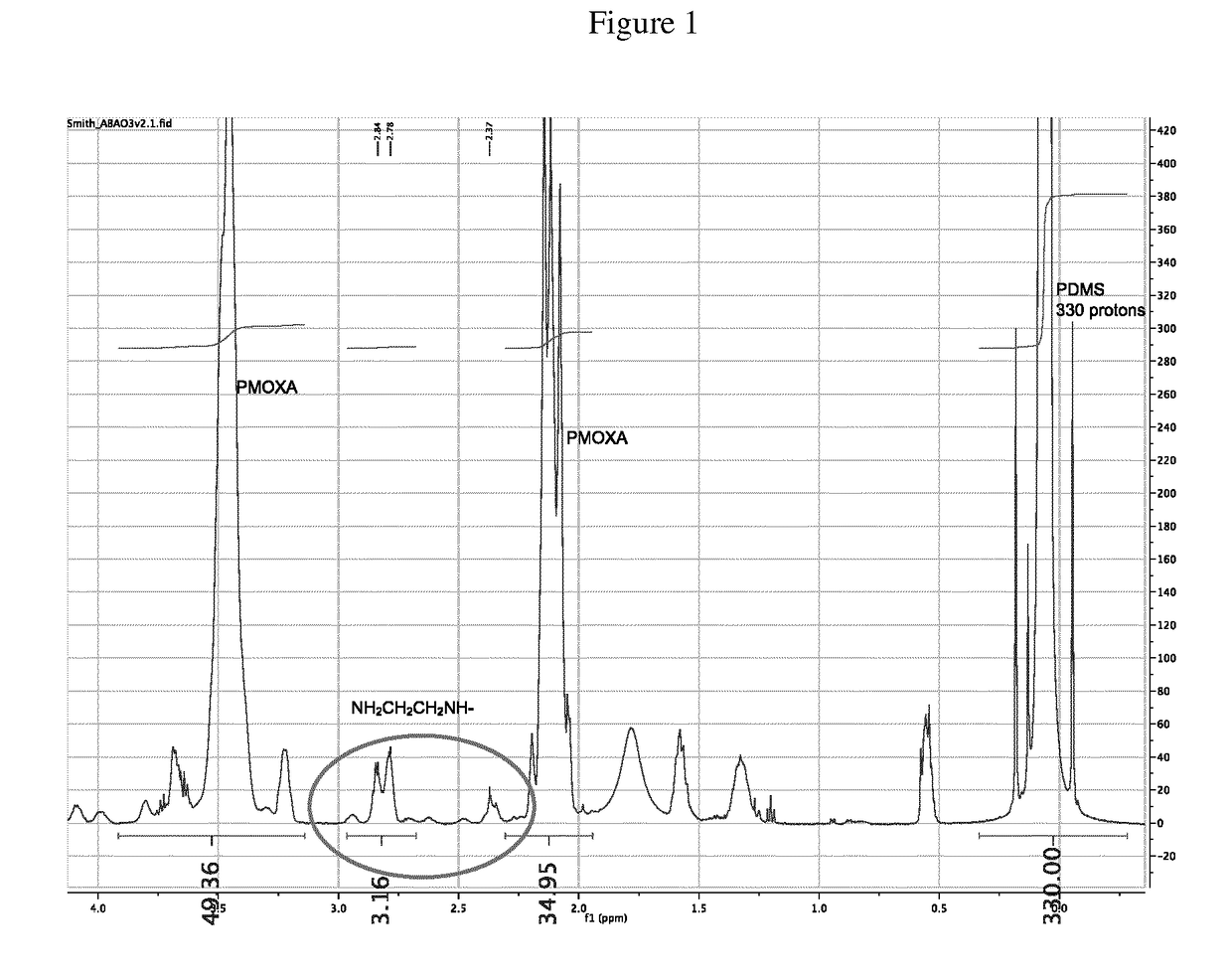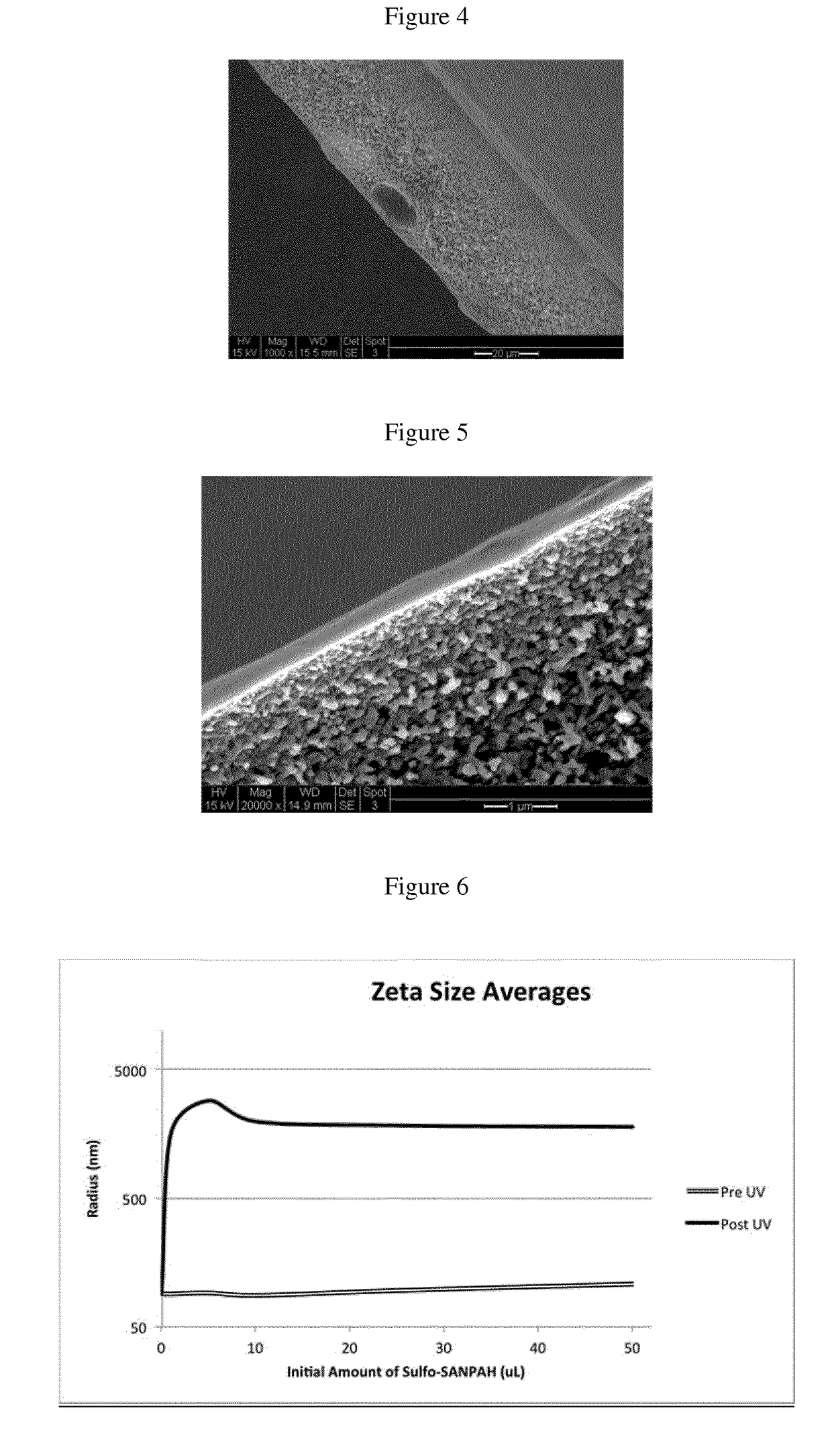Novel polymers and process for making membranes
a technology of membranes and polymers, applied in membrane technology, membranes, capsule delivery, etc., can solve the problems of limited flow rate obtainable by such a system, inability to withstand the high hydrostatic pressure that is required, and insufficient density of the imprinted polymer layer to prevent all of the solute and water molecules from permeating
- Summary
- Abstract
- Description
- Claims
- Application Information
AI Technical Summary
Benefits of technology
Problems solved by technology
Method used
Image
Examples
example 1
Materials
[0512]
ItemSupplierProd. #2-Methyl-2-OxazolineSigma137448TriethylamineSigma471283Hexane, AnhydrousSigma296090Ethylene DiamineSigma391085Trifluoromethanesulfonic AcidSigma176176Ethyl AcetateSigma270989Syringe gas tightHamilton100 mlReflux condenserThree-neck flask500 mlDry argonVacuum pumpVacubrandRC6Rubber septaEthanolSigma
Step a). α,ω-Hydroxy-butyl-poly-di-methyl-siloxane (PDMS) Synthesis
[0513]Targeting the molecular weight of 4000 g / mol, 93.03 g (0.34 mols) of octamethylcyclotetrasiloxane and 6.97 g (0.0025 mols) 1,3-bis(hydroxybutyl)-tetramethyldisiloxane were charged into a 3-necked round bottom Pyrex reactor with an argon inlet, thermometer and condenser. Trifluoroacetic acid 6.55 g (0.05755 mols) was added. The reaction mixture was heated at 60° C. for 48 hours. After this time the excess trifluoroacetic acid was extracted with distilled water until the aqueous extract was neutral. Then the reaction mixture was stripped off under high vacuum to remove the cyclic side p...
example 2
Materials:
[0516]ABA block-co-polymer, poly-2-methyl-2oxazoline-poly-dimethylsiloxane-poly-2-methyl-oxazoline, amine terminated, as prepared in Example 1[0517]Aquaporin-Z stock solution 1 mg / ml in 1% octyl glucoside and 100 mM NaMPOS buffer at pH 7.5[0518]100 mM NaMPOS buffer at pH 7.5[0519]Chloroform (Puriss)[0520]Octyl glucoside (Anatrace)[0521]Amine functional polymer vesicles 10 mg / mL in Na.MOPS[0522]PoPR (Polymer to Protein ratio, mass)[0523]N-sulfosuccinimidyl-6-(4′-azido-2′-nitrophenylamino)hexanoate, sulfo-SANPAH (Pierce; Product No. 22589)[0524]Dextrans (American Polymer Standards Corporation)[0525]365 nm UV lamp (Entela UVP)[0526]47 mm Membrane stamp[0527]25 mm Membrane stamp[0528]Polysulfone membrane; pore size 150 nm (cut-off over 1000 kDa)
1). Polymer Vesicles / Proteo-Vesicles Preparation:
[0529]50 mg of ABA block-co-polymer was dissolved in 2 ml of chloroform in a round bottom flask (Pyrex 100 ml). Chloroform was then removed under high vacuum to form a thin film of polyme...
examples 3 and 4
[0547]Model experiments were carried out to confirm the suitability of various polymer end-groups for the preparation of vesicles and the covalent linking of vesicles to each other. The comparison polymers were prepared as follows.
(a) Carboxylic-Terminated poly-2-methyloxazoline-poly-di-methyl-siloxane-poly-2-methyloxazoline (PMOXA-PDMS-PMOXA)
[0548]Hydroxyl-terminated polymer Mn=4262 g / mol (PDMS) synthesized as in step (a) of Example 1 was used in the synthesis of poly PMOXA-PDMS-PMOXA amphiphilic block copolymer. In a three-neck round bottom flask 50 grams (0.01173 mols) of PDMS was kept under high vacuum for 24 h. In the next step reaction the flask was filled with dry argon and polymer was dissolved in dry hexane (200 ml) added to the three-neck flask via septum. Cooled (0-5 deg C.) PDMS was than activated by drop-wise addition of 6.62 g (0.02346 mols) of trifluoromethanesulfonic anhydride in presence of 2.45 g (0.024 mols) of triethylamine and allowed to post-react for 3 hours. ...
PUM
| Property | Measurement | Unit |
|---|---|---|
| thickness | aaaaa | aaaaa |
| thickness | aaaaa | aaaaa |
| thickness | aaaaa | aaaaa |
Abstract
Description
Claims
Application Information
 Login to View More
Login to View More - R&D
- Intellectual Property
- Life Sciences
- Materials
- Tech Scout
- Unparalleled Data Quality
- Higher Quality Content
- 60% Fewer Hallucinations
Browse by: Latest US Patents, China's latest patents, Technical Efficacy Thesaurus, Application Domain, Technology Topic, Popular Technical Reports.
© 2025 PatSnap. All rights reserved.Legal|Privacy policy|Modern Slavery Act Transparency Statement|Sitemap|About US| Contact US: help@patsnap.com



